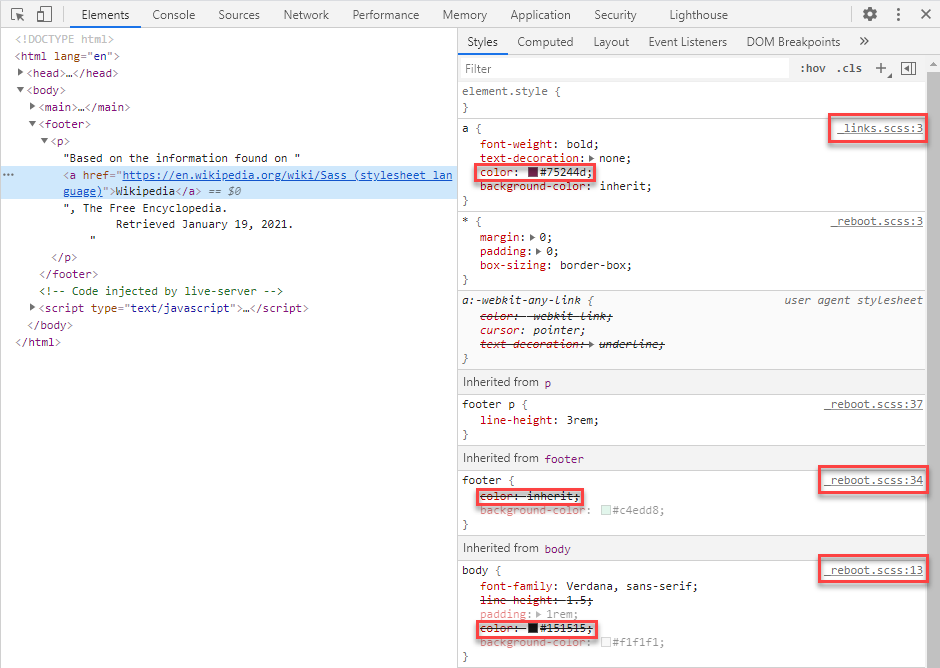# Partials
- To keep the file style.scss organized and maintainable, the Sass code herein is usually split into several partials, which we then import (in the correct order!) into style.scss
# Example 1E
- We illustrate this concept using Example 1E, which contains the same Sass code as Example 1D, but now re-organised in different partials (within the folder scss)
- The file names of the partials start with an underscore (_variables.scss, _mixins.scss, ...), indicating that these files
- are NOT compiled to CSS files (variables.css, mixins.css, ...)
- are (meant to be) imported into another Sass file (style.scss)
- The file names of the partials start with an underscore (_variables.scss, _mixins.scss, ...), indicating that these files
# _variables.scss
- Contains the declaration of the variables
$sasscolor: #cf649a; $fontstack: Verdana, sans-serif; $fontsize: 14px;Copied!
1
2
3
2
3
# _mixins.scss
- Contains the mixin(s)
@mixin colorcombo($front: #151515, $back: #f1f1f1){ color: $front; background-color: $back; }Copied!
1
2
3
4
2
3
4
# _reboot.scss
- Contains the (basic) layout of the page, apart from the styling of the links (see _links.scss below)
@use "sass:color"; * { margin: 0; padding: 0; box-sizing: border-box; } html { font-size: $fontsize; } body { font-family: $fontstack; line-height: 1.5; @include colorcombo; } main, footer { padding: 0 1rem; } h1 { @include colorcombo($sasscolor, inherit); } h1, p, ul { margin-bottom: 1rem; } li { margin-left: 2rem; } footer { @include colorcombo(inherit, color.scale(color.invert($sasscolor), $lightness:75%)); p { padding: 1rem 0; } }Copied!
1
2
3
4
5
6
7
8
9
10
11
12
13
14
15
16
17
18
19
20
21
22
23
24
25
26
27
28
29
30
31
32
33
34
35
36
37
38
39
40
41
2
3
4
5
6
7
8
9
10
11
12
13
14
15
16
17
18
19
20
21
22
23
24
25
26
27
28
29
30
31
32
33
34
35
36
37
38
39
40
41
# _links.scss
- Contains the layout of the links on the page
@use "sass:color"; a { font-weight: bold; text-decoration: none; @include colorcombo(color.scale($sasscolor, $lightness:-50%), inherit); &:focus { outline: 2px solid $sasscolor; } &:hover { text-decoration: underline; } }Copied!
1
2
3
4
5
6
7
8
9
10
11
12
13
14
15
2
3
4
5
6
7
8
9
10
11
12
13
14
15
REMARK
Observe that in both the files _reboot.scss and _links.scss the statement @use "sass:color" is included (as in both files functions from the sass:color module are used)
# style.scss
- All the partials are loaded into the main file style.scss (without underscore!) by using
@importstatements- Notice that the nor the underscore, nor the extension (.scss) is included in these
@importstatements - Obviously, the order of importing these partials is important!
- For example, if you would import the partial _reboot.scss before the partial _variables.scss, this would throw a bunch of errors as you would try to use variables in _reboot.scss that are not defined yet
- Notice that the nor the underscore, nor the extension (.scss) is included in these
@import "variables"; @import "mixins"; @import "reboot"; @import "links";Copied!
1
2
3
4
2
3
4
TIP
- It's considered to be good practice to
- have only
@importstatements (and no Sass code) in your main Sass file (style.scss) - divide your Sass code into similar partials as the one used in this example, i.e., partials containing the variables (_variables.scss), mixins (_mixins.scss) and layout for the website (_reboot.scss and/or specific files for specific elements, e.g. _links.scss)
- have only
REMARK: @import vs @use
- The Sass team discourages the use of the
@importrule, as it will be fased out gradually. Instead, the recently introduced module system (opens new window) based on the@userule will (also) become the future standard for loading partials.- Video tip for the interested reader: Sass Module System Update 2020 | SCSS import Deprecation (opens new window)
- Unfortunately, Bootstrap Sass (Bootstap's source/Sass code that we will study later on) still uses
@importstatements for loading its partials (as loading them with the@usemodule system does not yet work). Therefore, we decided to stick to the@importrule (for loading partials) for now.
# Source map
- At compile time, our compiler by default builds a source map style.css.map and adds it to the dist/css folder:

- This source mapping ensures that when you inspect the code of the web page (
F12), you can see in which partial the basis for the CSS was laid. This makes debugging a lot easier.- For example, if you right-click on the link in the
footerand inspect it, you will see that thecolorfrom the partial _reboot.scss is overwritten in the partial _links.scss
- For example, if you right-click on the link in the
